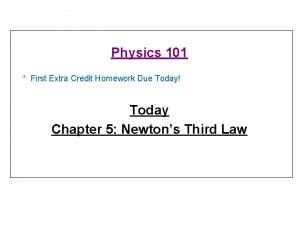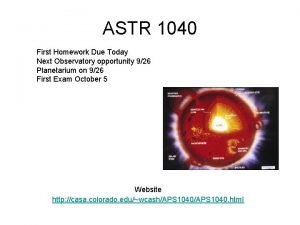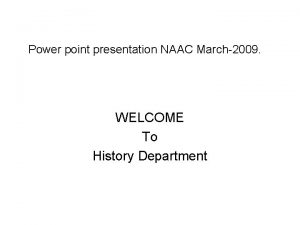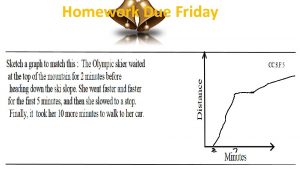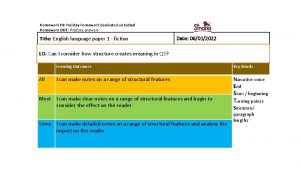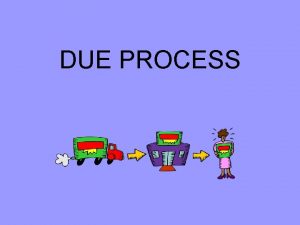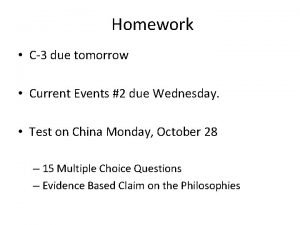Schedule Homeworks Homework 3 due to 23 March2009





















- Slides: 21

Schedule • Homeworks: – Homework 3, due to 23 -March-2009 17: 00 – Homework 4, due to 30 -March-2009 17: 00 • Reading homework – Golf (golfers by fried-lambrinos-tyler in EJOR 04. pdf): Next Tuesday (17 -03 -09) due to class time. – Oral and Yolalan (oralyolalan. pdf): due to class time on Thursday, 19 -03 -09. – Modell’s DEA (modell. pdf): due to class time on Thursday, 19 -03 -09.

Obtain file(s): • Copy and paste the excel file to your own accounts: F: COURSESUGRADSINDR 471SHARELabslab 3 -DLP-A-so. xls • Also open the power point file: F: COURSESUGRADSINDR 471SHARElabsDEA-Lab-12 -03 -09. ppt

Example: Data Store Employee Area Sales Profits A 10 20 70 6 B 15 15 100 3 C 20 30 80 5 D 25 15 100 2 E 12 9 90 8

Example: Results for A Efficiency of A: q. A =0. 93333 Reference set: RA={ lambda E } Employee (n 1, s 1 -) Area (n 2, s 2 -) Sales (u 1, s 1+) Profits (u 2 , s 2+) Optimal weights 0. 1 0 0. 013333 0 Slacks 0 11. 66667 0 0. 2222 Slacks DLP II-da formullerin icinde, optimal weights DLP I sensitivity shadow prices.

3. a. Discuss the meaning of u 1 of A, and its effect on the efficiency of A. How about u 2 of A? Compute the efficiency of A if the corresponding output is increased by one unit. How can you interpret the relation between the weights u 1 and u 2 of A, and the corresponding slacks, s 1+ and s 2+, using the complementary slackness condition? – if you increse the outputs by one the efficiency increses by the weights. Complementary slackness=S(i)*u(i)

3. b. Discuss the meaning of n 1 of A, and its effect on the efficiency of A. Note that a change in the employee input, n 1, changes the constraint (unlike a change in the outputs). Compute the efficiency of A if the Number of employees is decreased by one unit. – if you increse the inputs by epsilone E(new)=E(old)/(1 v(i)*epsilone)

Now: Make sure that in Excel: • Tools*Macro*Security: – Security Level “Medium” should be changed to “Low” • Tools*Options*International: – Decimal separators “. ” – Thousands separator “ , ”

The easy way … DEA solver • Copy the files into your own accounts: – F: COURSESUGRADSINDR 471SHARElabsLAB 3 -Ex 1 DEAsolver-data. xls, – F: COURSESUGRADSINDR 471SHARElabsLAB 3 -Ex 2 DEAsolver-data. xls – F: COURSESUGRADSINDR 471SHAREsoftware helpsDEASolver-LV. xls. – F: COURSESUGRADSINDR 471SHAREreading materialDEA SOLVER USER MANUAL. doc. • Open the file “DEA-Solver-LV. xls” • Click here to start OK CCR-I OK Choose Ex 1 DEAsolver-data. xls Run Save as Ex 1 -DEAsolver-CCR-I. xls

-Example 1 DEA Solver output: Weights

DEA Solver output for Example 1

DEA solver • Open the file “DEA-Solver-LV. xls” • Click here to start OK CCR-O OK Choose Ex 1 -DEAsolver-data. xls Run Save as Ex 1 -DEAsolver-CCR-O. xls

Questions - 1 • What are the efficiencies of the DMUs? Which DMUs have purely technical (or ratio) inefficiencies? • Relation between CCR-I (q*, v*, u*) and CCR-O (h *, p*, q*) ? – h* =1/ q* – m*= l*/q* – t-*=s-*/ q* , t+*=s+*/ q* – p* =v*/ q* , q* =u*/q*

Questions - 2 • What are the values of the slack variables for each of the DMUs? Identify the DMUs as efficient, ratio inefficient, mix inefficient and both ratio and mix inefficient. • Relation between CCR-I (q*, v*, u*) and CCR-O (h*, p*, q*) ? – h* =1/ q* – m*= l*/q* – t-*=s-*/ q* , t+*=s+*/ q* – p* =v*/ q* , q* =u*/q*

Questions - 3 • What are the values of lk’s? What are the level of inputs for each DMU to be efficient in CCR-I? • What are the values of mk’s? What are the level of outputs for each DMU to be efficient in CCR-O? • Relation between CCR-I (q*, v*, u*) and CCR-O (h*, p*, q*) ? – h* =1/ q* – m*= l*/q* – t-*=s-*/ q* , t+*=s+*/ q* – p* =v*/ q* , q* =u*/q*

DEA solver • Open the file “DEA-Solver-LV. xls” • Click here to start OK BCC-I OK Choose Ex 1 -DEAsolver-data. xls Run Save as Ex 1 -DEAsolver- BCC-I. xls

DEA solver • Open the file “DEA-Solver-LV. xls” • Click here to start OK BCC-O OK Choose Ex 1 -DEAsolver-data. xls Run Save as Ex 1 -DEAsolver- BCC-O. xls

Questions - 1 • What are the efficiencies of the DMUs? Which DMUs have purely technical (or ratio) inefficiencies?

Questions - 2 • What are the values of the slack variables for each of the DMUs? Identify the DMUs as efficient, ratio inefficient, mix inefficient and both ratio and mix inefficient.

Questions - 3 • What are the values of lk’s? What are the level of inputs for each DMU to be efficient in BCC-I? • What are the values of mk’s? What are the level of outputs for each DMU to be efficient in BCC-O?

Questions - 4 • What are the returns-to-scale (RTS) of DMUS in BCC-I and in BCC-O?

DEA Solver for Example 2… • For CCR-I, CCR-O, BCC-I, BCC-O … • Let’s answer the above questions for this one as well…
 Types of homeworks
Types of homeworks Homework oh homework poem
Homework oh homework poem Homework oh homework
Homework oh homework Homework oh homework i hate you you stink
Homework oh homework i hate you you stink Homework oh homework i hate you you stink
Homework oh homework i hate you you stink Consonance
Consonance Parts of a poem
Parts of a poem Homework due today
Homework due today Astr
Astr Homework is due on friday
Homework is due on friday Ilegalism
Ilegalism Homework due today
Homework due today Homework is due on friday
Homework is due on friday Homework due today
Homework due today Black cat analogy
Black cat analogy 3 weeks from today
3 weeks from today Homework is due
Homework is due Folk culture and popular culture venn diagram
Folk culture and popular culture venn diagram Substantive vs procedural due process
Substantive vs procedural due process Slidetodoc.com
Slidetodoc.com Due piccole sfere identiche sono sospese a due punti p e o
Due piccole sfere identiche sono sospese a due punti p e o Figura geometrica con 4 lati e 4 angoli uguali
Figura geometrica con 4 lati e 4 angoli uguali







